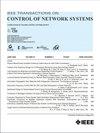有向网络多智能体优化的改进分布式梯度动力学
IF 4
3区 计算机科学
Q2 AUTOMATION & CONTROL SYSTEMS
引用次数: 0
摘要
研究了有向多智能体网络的分布凸优化问题。提出了一种连续时间协调算法来求解具有加性结构的无约束优化问题。所提出的算法可以解释为一个改进版本的分布式亚梯度方法,增强了一个增广的标量状态变量。假设每个agent都知道自己的out度。与现有的依赖于推和算法的扰动版本的方法不同,该算法不需要任何特定的初始化。因此,它能够处理大小偶尔变化的强连接网络。我们证明了当局部目标函数是强凸且具有lipschitz -连续梯度时,所提出的网络流保证收敛于凸函数和的全局极小值。此外,通过考虑一类允许的时变增益/步长,我们的分析证实了所提出算法的显式次线性收敛速度。本文章由计算机程序翻译,如有差异,请以英文原文为准。
A Modified Distributed Gradient Dynamics for Multiagent Optimization on Directed Networks
This article considers the distributed convex optimization problem over directed multiagent networks. We introduce a continuous-time coordination algorithm to solve unconstrained optimization problems with additive structure. The proposed algorithm can be interpreted as a modified version of the distributed subgradient method, enhanced with an augmented scalar state variable. Each agent is assumed to know its out-degree. Unlike existing methods that rely on a perturbed version of the push-sum algorithm, the proposed algorithm does not require any specific initialization. As a result, it is capable of handling strongly connected networks with sporadically varying sizes. We show that the proposed network flow is guaranteed to converge to the global minimizer of a sum of convex functions, provided that the local objective functions are strongly convex and have Lipschitz-continuous gradients. In addition, by considering a class of admissible time-varying gains/step-sizes, our analysis substantiates an explicit sublinear rate of convergence for the proposed algorithm.
求助全文
通过发布文献求助,成功后即可免费获取论文全文。
去求助
来源期刊

IEEE Transactions on Control of Network Systems
Mathematics-Control and Optimization
CiteScore
7.80
自引率
7.10%
发文量
169
期刊介绍:
The IEEE Transactions on Control of Network Systems is committed to the timely publication of high-impact papers at the intersection of control systems and network science. In particular, the journal addresses research on the analysis, design and implementation of networked control systems, as well as control over networks. Relevant work includes the full spectrum from basic research on control systems to the design of engineering solutions for automatic control of, and over, networks. The topics covered by this journal include: Coordinated control and estimation over networks, Control and computation over sensor networks, Control under communication constraints, Control and performance analysis issues that arise in the dynamics of networks used in application areas such as communications, computers, transportation, manufacturing, Web ranking and aggregation, social networks, biology, power systems, economics, Synchronization of activities across a controlled network, Stability analysis of controlled networks, Analysis of networks as hybrid dynamical systems.
 求助内容:
求助内容: 应助结果提醒方式:
应助结果提醒方式:


